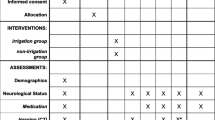Abstract
Objective
The purpose of this study was to assess for peri-operative factors associated with brain shift following craniotomy for subdural grid electrode placement.
Methods
A retrospective analysis of cases operated at a single institution was undertaken, examining 63 consecutive patients undergoing craniotomy for subdural grid placement for seizure monitoring between 2001 and 2007. Peri-operative records were reviewed in order to assess for intraoperative employment of osmotic duiresis. Postoperative MRI scans were analyzed for shift of the midline and brain displacement.
Results
One patient was excluded due to gross hemispheric atrophy confounding the midline, and four patients were excluded due to lack of available imaging. Hence 58 patients were radiographically reviewed. The employment of osmotic diuresis during grid placement appeared to be the most significant peri-operative factor influencing brain shift. Osmotic diuresis was administered in only 14 patients. Midline shift of the third ventricle was greater in the osmotic diuresis group (2.3 ± 0.3 mm vs. 1.5 ± 0.2 mm, p = 0.037). Moreover, the volume of shifted brain was significantly higher in the osmotic diuresis group (7.9 ± 0.5 cm3 vs. 4.7 ± 0.5 cm3, p = 0.003). There was no significant difference in the rates of neurological complications between patients who received osmotic diuresis and those who did not.
Conclusion
Employment of osmotic diuresis during grid placement appears to be associated with a paradoxical increase in the volume of shifted brain. This may be due to a combination of the resultant “sagging” of the brain and the pressure exerted by the grid, suggesting that osmotic diuresis might not improve mass effect as intended when employed within this context.


Similar content being viewed by others
References
Albert GW, Dahdaleh NS, Reddy C, Hansen DR, Vogel TW, Kawasaki H, Howard MA (2009) Postoperative radiographic findings in patients undergoing intracranial electrode monitoring for medically refractory epilepsy. J Neurosurg 112(2):449–454. doi:10.3171/2009.7.JNS09838
Fountas KN, Smith JR (2007) Subdural electrode-associated complications: a 20-year experience. Stereotact Funct Neurosurg 85(6):264–272. doi:10.1159/000107358
Hamer HM, Morris HH, Mascha EJ, Karafa MT, Bingaman WE, Bej MD, Burgess RC, Dinner DS, Foldvary NR, Hahn JF, Kotagal P, Najm I, Wyllie E, Luders HO (2002) Complications of invasive video-eeg monitoring with subdural grid electrodes. Neurology 58(1):97–103
Johnston JM Jr, Mangano FT, Ojemann JG, Park TS, Trevathan E, Smyth MD (2006) Complications of invasive subdural electrode monitoring at St. Louis children's hospital, 1994–2005. J Neurosurg 105(5):343–347. doi:10.3171/ped.2006.105.5.343
Lee WS, Lee JK, Lee SA, Kang JK, Ko TS (2000) Complications and results of subdural grid electrode implantation in epilepsy surgery. Surg Neurol 54(5):346–351. doi:S0090-3019(00)00324-4
Mocco J, Komotar RJ, Ladouceur AK, Zacharia BE, Goodman RR, McKhann GM 2nd (2006) Radiographic characteristics fail to predict clinical course after subdural electrode placement. Neurosurgery 58(1):120–125. doi:00006123-200601000-00013, Discussion: 120–125
Onal C, Otsubo H, Araki T, Chitoku S, Ochi A, Weiss S, Elliott I, Snead OC 3rd, Rutka JT, Logan W (2003) Complications of invasive subdural grid monitoring in children with epilepsy. J Neurosurg 98(5):1017–1026. doi:10.3171/jns.2003.98.5.1017
Wiggins GC, Elisevich K, Smith BJ (1999) Morbidity and infection in combined subdural grid and strip electrode investigation for intractable epilepsy. Epilepsy Res 37(1):73–80. doi:S0920121199000376
Wong CH, Birkett J, Byth K, Dexter M, Somerville E, Gill D, Chaseling R, Fearnside M, Bleasel A (2009) Risk factors for complications during intracranial electrode recording in presurgical evaluation of drug resistant partial epilepsy. Acta Neurochir (Wien) 151(1):37–50. doi:10.1007/s00701-008-0171-7
Conflicts of interest
None.
Author information
Authors and Affiliations
Corresponding author
Rights and permissions
About this article
Cite this article
Etame, A.B., Fox, W.C. & Sagher, O. Osmotic diuresis paradoxically worsens brain shift after subdural grid placement. Acta Neurochir 153, 633–637 (2011). https://doi.org/10.1007/s00701-010-0856-6
Received:
Accepted:
Published:
Issue Date:
DOI: https://doi.org/10.1007/s00701-010-0856-6




